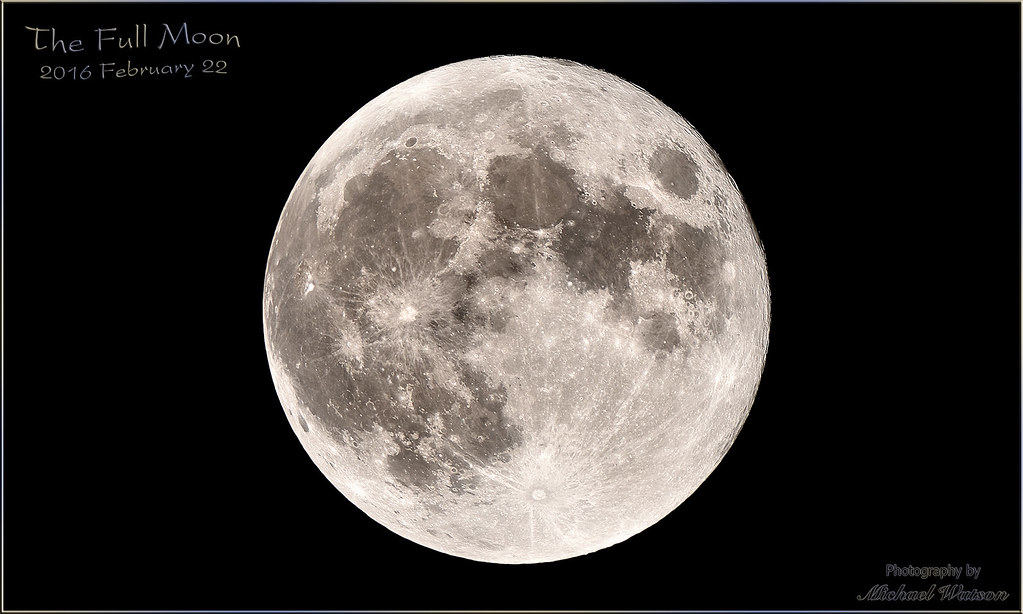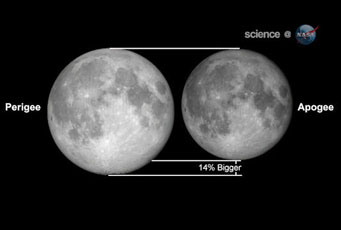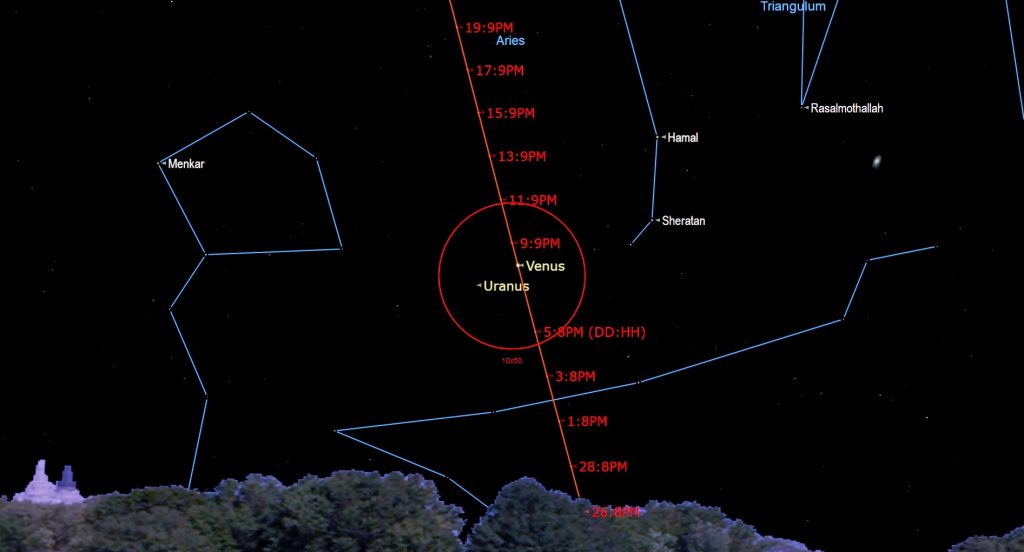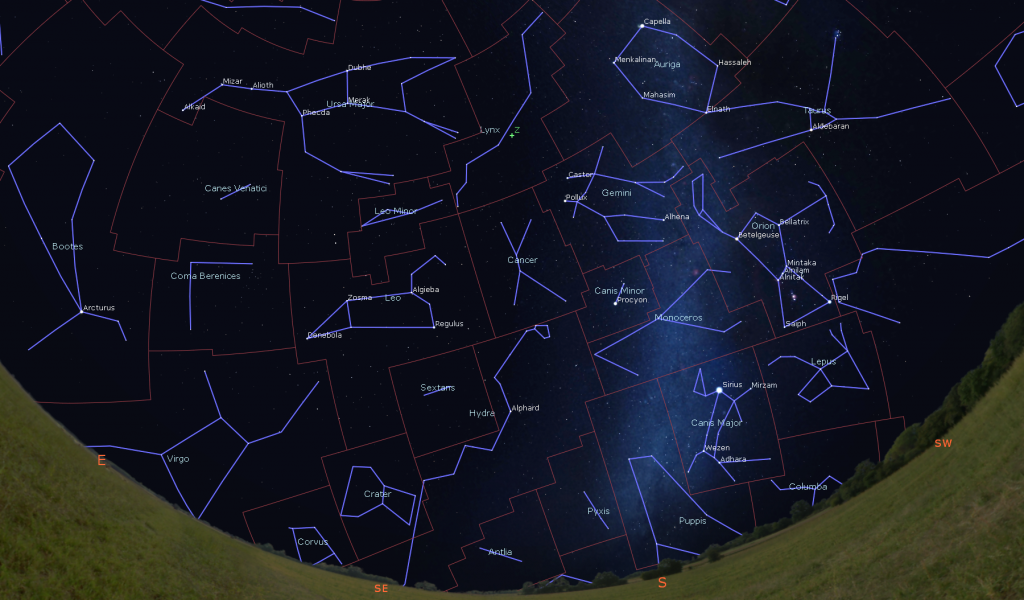The Largest Full Supermoon of 2020 Slides Over a Star, Bright Stars, Venus Passes Uranus, and Morning Planets in Motion!

This image of the moon by Michael Watson of Toronto was taken 9 hours after it was full on February 22, 2016 – replicating how the March, 2020 full moon will appear on Monday night. Note that the moon’s right-hand edge shows some shadowing – evidence that it is slightly past full. The many bright streaks, or rays, are white, highland rock material that has been ejected from the more recent craters. Those features are most visible during the full moon.
Hello, March Stargazers! Did you set your clocks forward one hour?
Here are your Astronomy Skylights for the week of March 8th, 2020 by Chris Vaughan. Feel free to send me your comments, questions, and suggested topics. You can also follow me on Twitter as @astrogeoguy! Unless otherwise noted, all times are expressed in Eastern Time. To receive Skylights by email, please click this MailChimp link.
I can bring my Digital Starlab portable inflatable planetarium to your school or other daytime or evening event. Contact me through AstroGeo.ca, and we’ll tour the Universe together!
Monday’s full moon will kick off supermoon season for 2020 and brighten the night sky all over the world – but I’ve got some bright stars to tide you over until the moon departs. The brilliant “Evening Star” Venus will pass close to Uranus as the week begins. Meanwhile, early risers can enjoy the motion of Mars, Jupiter, Saturn, and Mercury in the pre-dawn southeast. Here are your Skylights!
The Moon is Super
On Monday afternoon at 1:48 pm EDT (or 17:48 Greenwich Mean Time) the moon will reach its full phase. And, yes – moon phases can occur at any time of the day or night because the phase of the moon only depends on the angle formed by the sun, Earth, and moon, and not at all on the rotation of the Earth. As a matter of fact, only in Europe will this moon be exactly full when it rises. The rest of the world will see the moon a little before or a little after full at moonrise.
Every culture around the world has developed its own set of stories for the moon, and every month’s full moon nowadays has one or more nick-names. The indigenous Ojibwe people of the Great Lakes region call the March full moon Ziissbaakdoke-giizis “Sugar Moon” or Onaabani-giizis, the “Hard Crust on the Snow Moon”. For them it signifies a time to balance their lives and to celebrate the new year. The Cree of North America call it Mikisiwipisim, the “the Eagle Moon” – the month when the eagle returns. The Cherokee call it Anvyi, the “Windy Moon”, when the planting cycle begins anew. For Europeans, it is known as the Worm Moon, Crow Moon, Sap Moon or Lenten Moon.
The March full moon always shines among or near the constellations of Leo (the Lion) or Virgo (the Maiden), which are half the sky away from the sun’s position in Aquarius (the Water-Bearer). Because the moon can only appear full when it sits opposite the sun in the sky, full moons always rise in the east at sunset, and set in the west at sunrise. That full-on illumination by the sun’s light causes the moon’s geology to be enhanced, especially the contrast between the ancient cratered highlands and the younger, darker, smoother maria. Last month, I wrote here about the many interesting and easy-to-see features on the full moon.
The moon’s full phase will be peaking near mid-day on Monday in the Eastern Time Zone, so observers living in that region will see the moon as slightly less than full on Sunday evening. Binoculars will reveal a thin strip of darkened moon along the moon’s western limb. (That’s the moon’s left side for Northern Hemisphere observers – and the moon’s right side if you live down under.) The moon will look completely full on Monday evening, but there will be a slim band of darkness curving along its eastern limb.
This full moon will occur half a day before perigee, the point in the moon’s orbit when it is closest to Earth, generating high tides worldwide and making this the largest and brightest full moon of 2020 – the first of three consecutive supermoons. Let’s look at why that is.
The moon completes an orbit of the Earth every 27.3 days – so lunar perigees and apogees repeat on that interval. At perigee, the moon is about 14% closer to the Earth than at apogee, making it look a bit larger and brighter. Due to the Earth’s motion around the sun, the lunar phases, including full moons, repeat every 29.5 days. (The moon’s orbit time around Earth is called its sidereal period. The 2-day longer phase cycle time is called its synodic period, from the Greek word synodikos – a meeting or conjunction of people, or celestial objects.)
About every 14 months, the lunar orbital and lunar phase cycles synchronize for a few months, giving us a series of supermoons. (During that synchronization window, we also get corresponding apogee new moons. But new moons aren’t visible on Earth – unless a solar eclipse occurs. In fact, the June supermoon will be followed by an annular solar eclipse on June 21 – where the moon will be too far from Earth to completely block the sun, leaving an annulus of sun revealed around it.)

The term supermoon was coined by an astrologer named Richard Nolle in 1979. He defined it to be a full moon that occurs when the moon is within 90% of its minimum distance from Earth. The term is not officially recognized by astronomers because supermoons are not really “super” at all. Beyond being somewhat brighter and larger, no unusual effects or phenomena arise from them – and most people wouldn’t realize one is happening if the media didn’t promote it.
Although it’s about 7% larger than average, don’t expect the moon to look much different – despite all the hype. Don’t forget that any moon, even a supermoon, can easily be covered by your pinky fingernail held at arm’s length and one eye closed! By the way, a syzygy is the astronomical term for an alignment of three celestial objects – in this case, the sun, Earth, and moon. So this moon will be a lunar perigee syzygy.

As an extra bonus, at 8:18 pm EDT on Monday evening, a medium-bright star named Nu (ν) Virginis will pop out from behind the moon, near the moon’s top edge. The sight will be best seen in telescopes and strong binoculars. The time of egress varies depending on your latitude, so start watching a few minutes beforehand. For observers in Eastern Canada and the northeastern USA, the moon will already be in view above the eastern horizon before it covers the star at 23:23 GMT, or 7:23 pm Atlantic Time. For the rest of the night, the moon’s orbital motion will carry it farther from that star.
After Monday night, the moon will wane in phase and rise later each night. The moon will travel through Virgo (the Maiden) until Thursday night, when it will rise shortly before midnight local time among the stars of Libra (the Scales). Before dawn on the coming weekend, look for the waning half-moon in the southern sky, sitting above the stars of Scorpius (the Scorpion). That moon will also persist into the southern morning sky after sunrise.
Evening Zodiacal light
For about half an hour after dusk during the two-week period preceding the new moon on March 24, look west-southwest for a broad wedge of faint light rising from the horizon and centered on the ecliptic below Venus. This is the zodiacal light – reflected sunlight from interplanetary particles of matter concentrated in the plane of the solar system. Try to observe from a location without light pollution, and don’t confuse the zodiacal light with the brighter Milky Way, which extends upwards from the northwestern evening horizon at this time of year. Observers in the Southern Hemisphere can see the zodiacal light in the eastern pre-dawn sky starting around March 23.
Venus’ brightness will likely spoil the fun this year, but the phenomenon will re-occur next year around this time, and Venus won’t be there.
The Planets
Extremely bright Venus will dominate the western evening sky for the next two months. Our sister planet will start to catch your eye well before dusk, and then set prior to midnight in your local time zone. Believe it or not, Venus is still brightening! Right now, Venus’ magnitude value is -4.35. It will reach maximum brightness on April 28. (The more negative the magnitude value, the brighter an object looks. The sun shines at magnitude -26.7 and the brightest star, Sirius, shines at -1.45.)

Tonight (Sunday evening) the faster orbital motion of Venus will place it close to comparatively dim and blue-green coloured Uranus. Uranus will be positioned two finger widths to the upper right (or 2° to the celestial south) of Venus. Until about Tuesday, both planets will appear together in the field of view of binoculars and telescopes – although Uranus, which shines at magnitude +5.8, will be about a thousand times fainter than Venus! Uranus will still be there every night, but Venus upward motion in the sky away from Uranus will make Venus less helpful in locating Uranus.
If you want to see Venus’ less-than-fully-illuminated disk, aim your telescope at the planet as soon as you can pick it out of the darkening sky. In a twilit sky, Venus’ shape shape will be more apparent. And, when Venus is higher in the sky you’ll be viewing the planet more clearly – through less of Earth’s distorting atmosphere. I recommend that you view Uranus while it’s higher, too – but after the sky has darkened. (Don’t forget that your telescope will flip and/or invert the arrangement of the planets – but binoculars will not.)
The month of March will be featuring some planetary playing in the southeastern pre-dawn sky! That’s where Mars, Jupiter, Saturn, and Mercury are strung out in a chain along the ecliptic. If you have an open view of the southeastern horizon, those planets will be very easy to see with your unaided eyes every morning. Mercury will be there, too – but lower, and therefore tougher to spot.
The fun begins after about 4:40 am in your local time zone. That’s when reddish Mars will rise. Much brighter, and whiter, Jupiter will follow it about 15 minutes later. And medium-bright, yellowish Saturn will join them half an hour after that, at about 5:30 am. Three planets will be nicely visible against a dark sky until almost 7 am. After that, Mars and Saturn will fade from view, but Jupiter will remain visible until sunrise. By the way, Jupiter’s Great Red Spot will be in view on Wednesday morning, March 11 and on Friday morning, March 13.

On Monday morning, all three planets will sit within 1.4 fist diameters (or 14°) of one another, with Jupiter in the middle. While Jupiter and Saturn will maintain their spacing, faster Mars will move closer to Jupiter every morning. It will pass Jupiter next week and then Saturn some time after that.
Speedy little Mercury will be appearing over the east-southern horizon this week. It will start out widely separated from the other three planets, but it will rapidly move westward towards them during the next two weeks. The best viewing times this week are between 6:45 am and 7 am local time, but observers who live closer to the equator will have better luck seeing it.
Stars to look at on a Moon-filled Week
Last week, I wrote about some bright stars to enjoy despite the bright moonlight, including the huge Winter Football asterism and Orion (the Hunter). I posted it here.
If you have a backyard telescope, point it at the star Castor in Gemini (the Twins). It will split into two because Castor is a multiple star system. And don’t forget to take a peek at the bright, pretty, little Pleiades star cluster above Venus.
Finally, look to the east after 9 pm local time for the bright, warm-tinted star Arcturus shining just above the horizon. That star brings the promise of the summer stargazing season!

Public Astro-Themed Events
Every Monday evening, York University’s Allan I. Carswell Observatory runs an online star party – broadcasting views from four telescopes/cameras, answering viewer questions, and taking requests! Details are here. On Wednesday nights they offer free public viewing through their rooftop telescopes, including their brand new 1-metre telescope! If it’s cloudy, the astronomers give tours and presentations. Registration and details are here.
At 7:30 pm on Wednesday, March 11, the RASC Toronto Centre will hold their free monthly Speaker’s Night Meeting at the Ontario Science Centre, and the public are welcome. This month, the speaker will be Jenna Hinds, Youth Outreach Coordinator at The Royal Astronomical Society of Canada. Her topic will be Jellyfish I Have Known: The Aquatic and the Nebulous, the story of her travels in life and on the globe. Parking is free. Details are here.
On Wednesday evening, March 11 at 7:30 pm, the Hot Docs Ted Rogers Cinema – Curious Minds Festival will feature well-known physicist Brian Greene discussing Understanding the Cosmos—and Our Place Within It. Tickets and details are here.
This spring, spend a Sunday afternoon in the other dome at the David Dunlap Observatory! On Sunday, May 3, from 1 to 4 pm, join me in my Starlab Digital Planetarium for an interactive journey through the Universe at DDO. We’ll tour the night sky and see close-up views of galaxies, nebulas, and star clusters, view our Solar System’s planets and alien exo-planets, land on the moon, Mars – and the Sun, travel home to Earth from the edge of the Universe, hear indigenous starlore, and watch immersive fulldome movies! Ask me your burning questions, and see the answers in a planetarium setting – or sit back and soak it all in. Sessions run continuously between noon and 2 pm, and repeat from 2 to 4 pm. Ticket-holders may arrive any time during the program. The program is suitable for ages 3 and older. The Starlab planetarium is wheelchair accessible, but everyone else sits at floor level. For tickets, please use this link. Tickets for future dates will be available soon.
Keep looking up, and enjoy the sky when you do. I love questions and requests. Send me some!